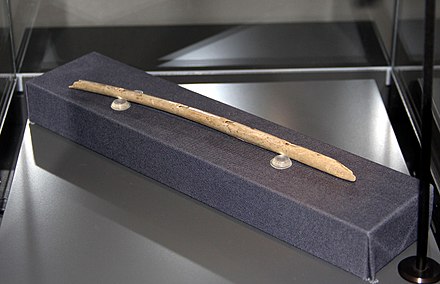The oldest instruments in the world?
- Published: Tuesday, 29 September 2020 10:06
- Written by Lionel Tabourier translated by Muriel Halaoui
- Hits: 3084
Several archaeological sites in the Swabian Jura, Germany, have led to the discovery of Paleolithic flutes in recent decades. In 2012, precise dating showed that these flutes are probably the oldest known human musical instruments.
 Hohle Fels bone flute |
In 2008, while exploring the Hohle Fels cave in Baden-Württemberg, a team of archaeologists from the University of Tübingen unearthed archaeological treasures dating back 35,000 years. Amongst these, an ivory Venus, and pieces of several flutes, made of bone and ivory.
The best-preserved fragment comes from a 22 cm flute made from a vulture bone. We can see the notch for placing the lips there, as well as notches near the holes, which would have been used by the designer of the object. Wooden replicas have shown that this instrument produces notes like those of some of current flutes.
According to Professor Nicholas J. Conard and his collaborators, authors of the discovery, these instruments would probably be the work of Homo sapiens, because the technique differs greatly from what is known about the productions of Homo neanderthalensis, or Neanderthal man, who was also present in the region at that time.
Mammoth ivory flute (Geissenklösterle) |
Since their discovery, these flutes were the oldest musical instruments known and attested as such. But in 2012, Professor Tom Highman’s team from Oxford University carried out high-resolution carbon-14 dating on mammoth ivory flutes from the nearby Geißenklösterle site. These turned out to be even earlier: they would date from 42,000 to 43,000 years ago.
The recreational or religious function of these instruments has not yet been established. Either way, these findings push back the date when human music was thought to have emerged. They demonstrate the high degree of cultural sophistication achieved by Paleolithic people in this region. Some researchers even hypothesize that music could have played a role in building a larger social network, thus promoting the territorial expansion of sapiens to the detriment of its Neanderthal cousin.
Sources: Nature (published August 2009), Journal of Human Evolution (published June 2012), BBC (published May 2012), Futura Sciences (published June 2009), Sci News (published May 2012). Consultées en Octobre 2017.






